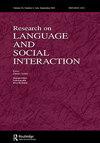Affiliating in Second Position: Response Tokens with Rising Pitch in Danish
IF 2.1
1区 文学
Q1 COMMUNICATION
引用次数: 7
Abstract
ABSTRACT This article examines the use of the Danish response tokens ja (“yes”) and nej (“no”) with rising pitch in everyday interaction in Danish. Ja and nej do more than (dis)confirmation, and the analysis shows that the tokens with rising pitch achieve affiliation in second position in sequences containing displays of affective stance, which is shown to be contrastive with the tokens with level pitch that instead disaffiliate in the same sequences. Turns eliciting the tokens are also often marked with a wide pitch span, but sometimes other prosodic features than pitch are employed to perform a display of affective stance. Eliciting turns often request reconfirmation but can also implement other actions that make ja or nej a relevant response. The affiliation achieved is shown to be similar across both ja and nej when doing a range of actions, such as (dis)confirmation, acceptance, or agreement. Data are in Danish.处于第二位的附属关系:丹麦语中音调上升的响应标记
摘要:本文考察了丹麦语应答标记ja(“是”)和nej(“否”)在丹麦语日常互动中的使用情况。Ja和nej所做的不仅仅是(dis)证实,分析表明,在包含情感立场显示的序列中,音调上升的标记在第二位置实现了附属,这与音调水平的标记相反,后者在相同序列中脱离了附属。引发表征的转折通常也标有宽的音高跨度,但有时会使用音高以外的其他韵律特征来表现情感立场。Eliciting回合通常要求再次确认,但也可以实施其他行动,使ja或nej成为相关的回应。在进行一系列行动时,如(dis)确认、接受或同意时,ja和nej的隶属关系是相似的。数据为丹麦语。
本文章由计算机程序翻译,如有差异,请以英文原文为准。
求助全文
约1分钟内获得全文
求助全文
来源期刊
CiteScore
7.30
自引率
7.40%
发文量
20
期刊介绍:
The journal publishes the highest quality empirical and theoretical research bearing on language as it is used in interaction. Researchers in communication, discourse analysis, conversation analysis, linguistic anthropology and ethnography are likely to be the most active contributors, but we welcome submission of articles from the broad range of interaction researchers. Published papers will normally involve the close analysis of naturally-occurring interaction. The journal is also open to theoretical essays, and to quantitative studies where these are tied closely to the results of naturalistic observation.

 求助内容:
求助内容: 应助结果提醒方式:
应助结果提醒方式:


